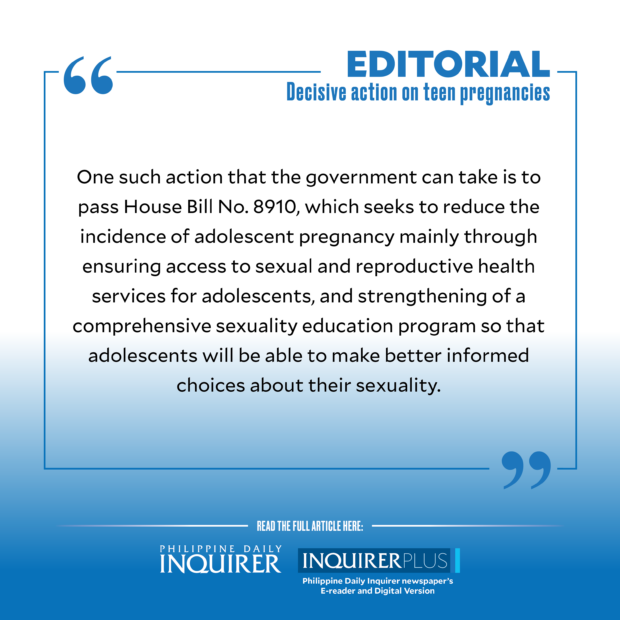Decisive action on teen pregnancies

First the good news: teenage pregnancy among 15- to 19-year-olds in the Philippines has declined from 8.6 percent in 2017 to 5.4 percent in 2022, evidence that intervention programs such as sexual health education campaigns are taking root and yielding positive results.
But these are clearly still not enough as here comes the bad news: more 10- t0 14-year-olds are becoming mothers far earlier than they should, with births rising by 11 percent from 1,903 in 2016 to 2,113 in 2020, according to the Philippine Statistics Authority.
What’s worse is that the number spiked further over the past few years by an alarming 35.13 percent. According to the Commission on Population and Development (CPD), live births among girls 15 years old and below surged to 3,135 in 2022 from 2,320 in 2021.
Mired in poverty
This may be equivalent to just a minuscule 0.22 percent of total live births, but remains a cause for grave concern, according to CPD executive director Lisa Bersales.
“The statistics vary depending on the source of data, but they are all worrying,” Bersales underscored in a House panel last year.
After all, an early and unplanned pregnancy robs these minors of not just their childhood but more likely their future as well, as early pregnancy almost always means that the young girls—most of whom come from poor and marginalized families—will not finish even basic education, thus will lack the skills and knowledge they will need to earn enough. This unfortunate circumstance keeps them mired in poverty.
Rejection and violence
The United Nations (UN) Children’s Fund had also noted that young mothers face negative social consequences such as rejection and violence by family members, peers, and partners, and early and forced marriage, not to mention the possible health consequences of pregnancy and delivery as their bodies may not be physically ready.
Fortunately, the Senate appreciates the gravity of the situation with Sen. Sonny Angara filing a resolution last year to inquire into the alarming increase in pregnancies among 10- to 14-year-olds, to take “a whole-of-government approach” in developing a policy framework to prevent early childbearing.
Decisive action
Sen. Sherwin Gatchalian was equally alarmed and for his part sought a more effective rollout of the Department of Education’s Comprehensive Sexuality Education.
“Nakakabahala ang pagdami ng bilang ng mga batang ina, lalo na’t hinaharap ng mga kabataang ito ang panganib na matigil sa pag-aaral at makaranas ng karahasan. Mahalagang tiyakin nating nasa paaralan ang mga babaeng mag-aaral, at matatanggap nila ang epektibong sexuality education para sa kanilang sapat na kaalaman at proteksyon,” said Gatchalian, chair of the Senate committee on basic education.
While these are welcome proposals, what is more critical now is “decisive action” by the government and its partners to address the worrying increase in pregnancy among 10- to 14-year-olds, according to the UN Population Fund Philippines.
Informed choices
One such action that the government can take is to pass House Bill No. 8910, which seeks to reduce the incidence of adolescent pregnancy mainly through ensuring access to sexual and reproductive health services for adolescents, and strengthening of a comprehensive sexuality education program so that adolescents will be able to make better informed choices about their sexuality.
Concerns over the increase in child and teenage births have been raised as far back as 2011, and steps have been taken such as the issuance by former president Rodrigo Duterte of Executive Order No. 141 that declared as a national priority the implementation of measures to address the root causes of the rising number of adolescent pregnancies.
Relics of the past
There have been demonstrated gains but with the problem of younger Filipinos getting pregnant coming to fore, more drastic measures have to be taken such as the passage of HB 8910 into law that will make way for the government and other stakeholders to collaborate more effectively to arrest the rise in pregnancy among children and teenagers.
Albay Rep. Edcel Lagman, principal author of HB 8910 that was passed by the House in September last year and now awaiting resolution in the Senate, said that the specific law would help “save young girls from the clutches of maternal death, unemployment, and poverty, and improve their future and reinforce their self-esteem.”
As Lagman had long stressed, adolescent mothers should be relics of the very distant past when early childbearing was the norm.
“If we are to truly uplift the lives of women, we must start by improving the future of young girls,” Lagman said.




















